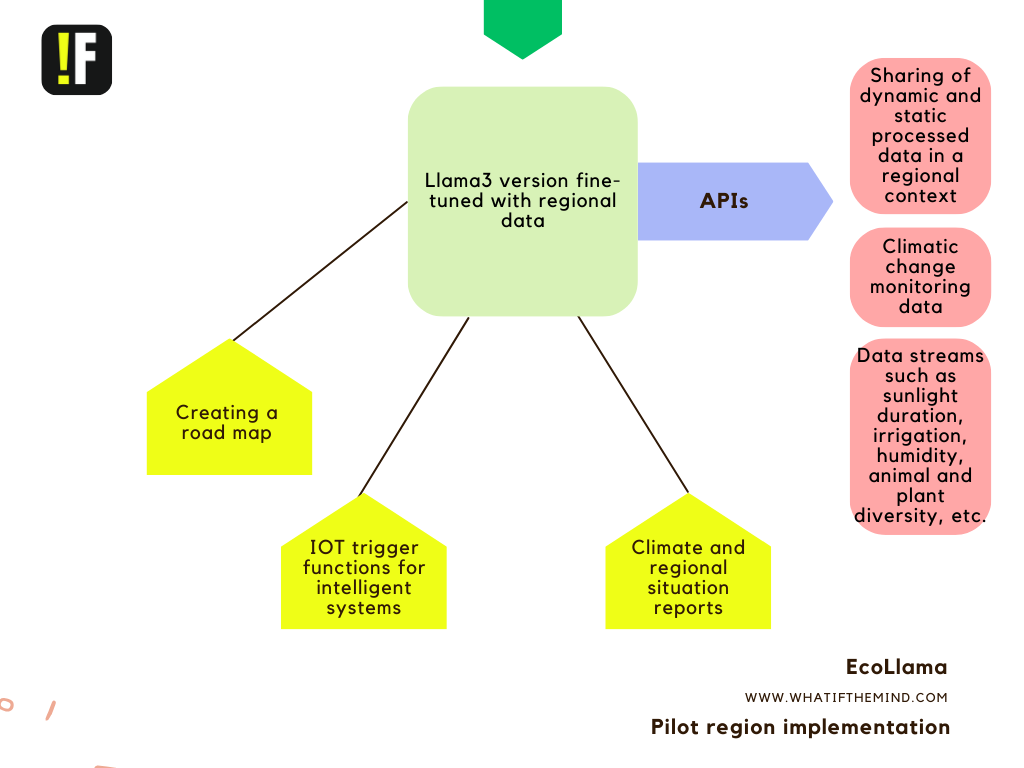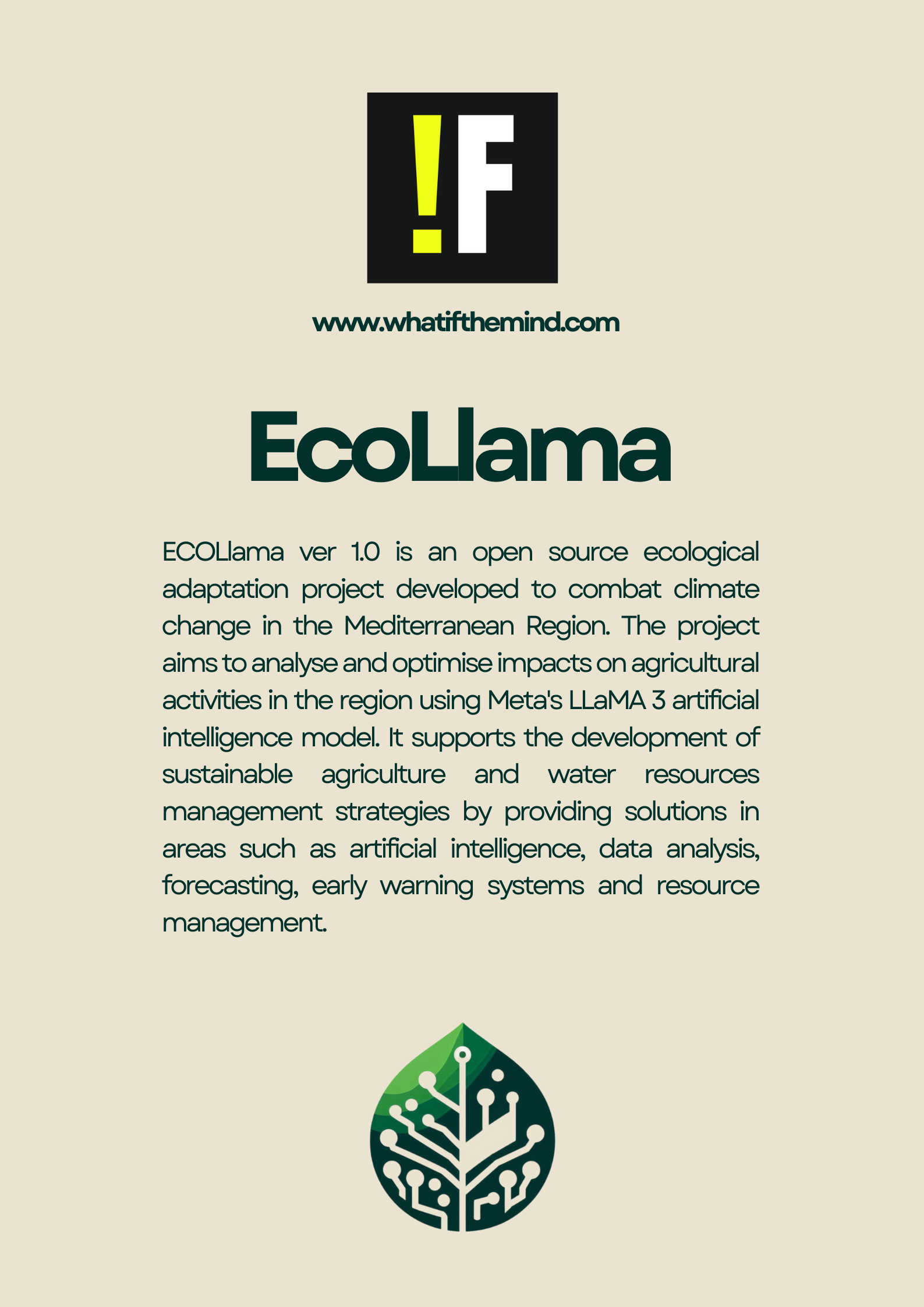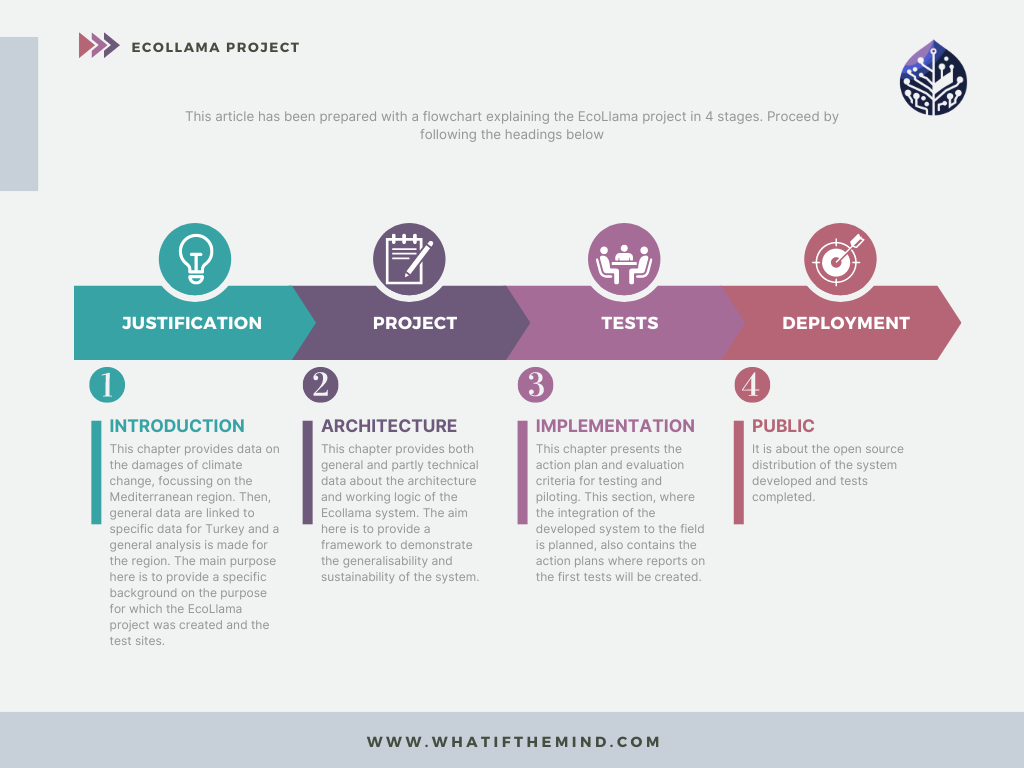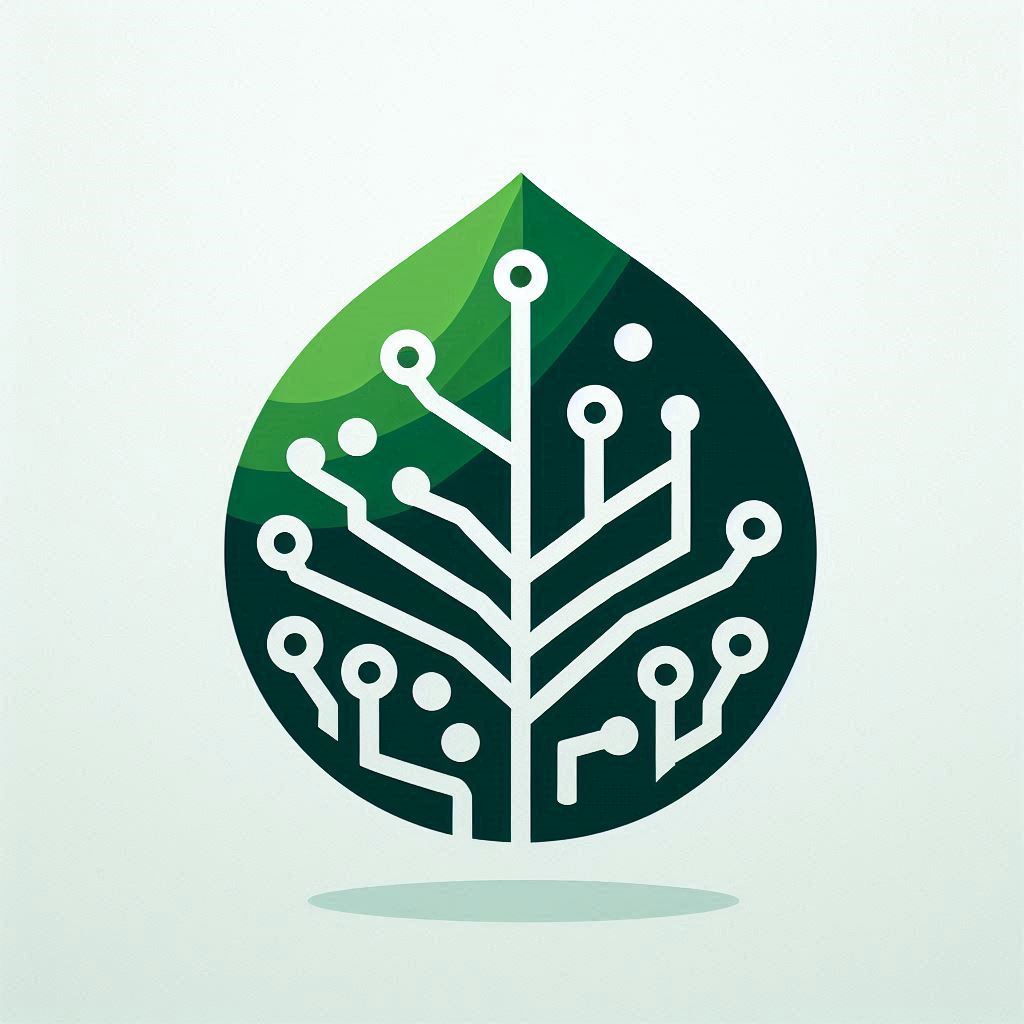Building on the #Llama3, #EcoLlama uses an experimental approach to generate synthetic data. The evaluation includes a comparison of traditional climate simulations and EcoLlama simulations inspired by game theory. EcoLlama models various climate scenarios using historical and current data and generates synthetic data. These data are compared with other climate analyses to determine the most suitable crops for agricultural production. The model provides strategies to mitigate the impacts of #climatechange.
Note that the game in the article contains only a simple example. Real-world examples can be more complex...
Caution: The Focal Mechanism concept in this paper is a hybrid and novel construct derived from the attention mechanism algorithms used in language models and the Focal Mechanism algorithms used in image processing.
Summary
In the last 50 years, the Mediterranean regions of Turkey have been subjected to severe impacts of climate change. Rising temperatures, changing precipitation patterns and frequent extreme weather events have negatively affected ecosystems, agriculture and the local economy. For example, the drought of 2023 led to a 40 per cent reduction in water resources in the region, severely disrupting agricultural production.
International organisations such as the European Union (EU) and the United Nations (UN) have taken important steps to combat climate change in recent years. The EU has implemented the Green Deal, which aims to reduce carbon emissions by 55% by 2030, while the UN is promoting global climate action under the Sustainable Development Goals. These organisations have developed various strategies to mitigate the devastating effects of climate change, such as increasing the use of renewable energy sources, improving energy efficiency and reducing carbon emissions.
The dangers of climate change are not only environmental but also socio-economic and health risks. At this point, the ECOLlama ver 1.0 project comes into play. ECOLlama ver 1.0, an open source ecological adaptation project that aims to increase resistance and adaptation to these changes, aims to increase efficiency and sustainability in agricultural activities by using Meta's open source LLaMA 3 artificial intelligence model.
By utilising the deep learning and natural language processing capabilities of LLaMA 3 for the analysis, prediction and management of climate data, strategies suitable for local climate conditions will be developed. This project aims to make significant contributions to sustainable agriculture and water resources management by addressing socioeconomic and environmental impacts while providing innovative solutions to combat climate change. Within the scope of the project, the concept will be concretised and its applicability will be tested through pilot region applications.
Keys: Llama3, EcoLlama 1.0, Climate, Mediterranean, Artificial intelligence
Mediterranean Region and Turkey:
The fact that the economic structures of developing countries are based on agricultural production causes these countries to be more deeply and directly affected by climate change. Especially extreme weather conditions cause mass migration in these regions by making agricultural production difficult or even impossible. According to United Nations estimates, more than 500 million people have been displaced worldwide due to climate change. Despite significant advances in pesticide, fertiliser and irrigation systems in the agricultural sector, climatic conditions still play a decisive role in production.
The agriculture sector is one of the most vulnerable sectors to climate change. Climate change both affects agriculture and agricultural activities contribute to climate change. Agricultural activities in tropical and subtropical regions are adversely affected by unusual floods and droughts, while in temperate regions, an extended growing season can lead to an increase in agricultural production. In arid regions, on the other hand, desertification caused by increasing temperatures leads to a decrease or even extinction of agricultural production. The impacts of climate change on agriculture are manifested in food security, development and international trade. The decrease in the amount of production leads to inflation by increasing agricultural prices, an increase in the current account deficit as a result of meeting the supply deficit in agricultural products through imports, a decrease in employment in the agricultural sector and the compensation of losses of producers by governments have a negative impact on the budget. The agricultural and economic impacts of climate change depend on the rate and severity of climate change and the ability of agricultural production to adapt to these changing conditions. Impacts on agricultural yields are caused by factors such as temperature, precipitation, CO2 content in the atmosphere, frequency of extreme events and sea level rises (Bayraç, Doğan 2016).
The Mediterranean region plays an important role in agricultural production with its geographical location and climate characteristics. However, increasing temperature and irregular rainfall in recent years have serious impacts on agricultural activities in the region (UNEP, 2022). Especially drought periods threaten the sustainability of irrigation systems and negatively affect agricultural productivity.
Turkey is located in a geography where the Mediterranean climate shows diversity. Especially in the Mediterranean region, important agricultural products such as olives and citrus fruits are grown. However, climate change deeply affects the agricultural sector by changing the growing conditions of these products (IPCC, 2021).
In the last 50 years, climate change in the Mediterranean region of Turkey has been clearly observed. During this period, significant changes such as temperature increases, changes in precipitation regime and prolonged drought periods have been experienced. There has been a noticeable increase in average temperatures, especially in the summer months, and at the same time, irregularities in the amount of precipitation have been observed in the winter months (TUIK, 2023).
Turkey is in the high risk group in terms of the impacts of global warming. Climate changes are expected to have serious negative impacts on agricultural activities, animal and plant habitats and water resources. Increased accumulation of greenhouse gases in the atmosphere will exacerbate water resources problems in arid and semi-arid regions of Turkey in the future and increase agricultural and drinking water needs. This situation will lead to the expansion of arid and semi-arid areas, increase in the duration and severity of summer droughts, and thus increase the rate of desertification, salination and erosion. The negative impact of drought on agricultural production and producers will lead to producers having to adapt their crops to new seasonal conditions. Therefore, it is of great importance to develop and support agricultural plant varieties suitable for warmer and drier climatic conditions in Turkey.
Climate changes have led to an increased need for irrigation in agricultural areas, imbalances in local ecosystems and difficulties in the management of water resources. In addition, there have been impacts on agricultural product diversity, and some traditional plant species have been replaced by species that are more suitable for climatic conditions. These species sometimes have a negative impact on the habitat in the region, affecting animal and plant populations.
Today, the negative impacts of climate change are increasing in the Mediterranean region of Turkey. Due to high temperatures and low rainfall, water resources are decreasing and agricultural productivity is decreasing. This situation directly affects local economies and communities and threatens the sustainability of agricultural enterprises (FAO, 2022).
Socioeconomically, problems such as decrease in agricultural incomes, increase in unemployment and migration movements arise. Socially, loss of agriculture-related cultural heritage and decline in the quality of life of local communities are observed. In natural habitats, the risk of species migration or extinction increases (WWF, 2023).
Temperature increases threaten the tourism sector and the sustainability of natural resources. This can negatively affect employment and dependence on local economies (FAO, 2023).
In the future, the impacts of climate change in the Mediterranean region are expected to become more severe. These include more frequent and intense periods of drought, greater stress on water resources, severe declines in agricultural production and deepening imbalances in ecosystems. This poses a serious threat to the future of the region's biodiversity, economy and social structure (IPCC, 2021).
Urgent and effective steps need to be taken on these issues for a sustainable future. Many measures and practices are being implemented worldwide within the scope of combating climate change. These practices include studies in various fields such as promoting renewable energy sources, increasing energy efficiency, and reducing greenhouse gas emissions. In addition, smart agricultural practices are being developed to reduce the risk of agriculture being affected by climate change and strategies are being developed for the sustainable management of water resources. In addition to these efforts, it is also important to protect natural habitats and support biodiversity. These various practices at the global level contribute to the adoption of a multifaceted and integrated approach in combating climate change. In terms of adaptation measures, strategies such as strengthening infrastructures to adapt to environmental changes, promoting the efficient use of water resources and being prepared for natural disaster risks stand out (IPCC, 2014).
The Use of New Technologies within the Scope of Combating Climate Change and Adaptation to Climate Change: Llama3 Example
Today, with developing technologies, we have new and powerful tools to combat climate change. Artificial intelligence (AI) technologies play an important role in this struggle, offering innovative solutions to understand, predict and take measures against the impacts of climate change.
AI technology has great potential to analyse and model climate data and make predictions. In particular, AI-based systems in combating climate change provide important information to decision makers by enabling fast and accurate processing of environmental data. These systems are used to determine the possible impacts of climate change, assess risks and develop appropriate strategies.
Meta's open source LLaMA 3 model is thought to be a good pillar of this challenge. LLaMA 3 offers high processing capacity and learning capabilities thanks to its version trained with 70 billion parameters. When retrained with region-specific data and integrated into an external focal mechanism, the computational capabilities of LLaMA 3 will enable the establishment of a holistic and dynamic system to combat climate change.
LLaMA 3 can effectively process and analyse complex climate data with its powerful algorithms in deep learning and natural language processing. Thanks to these features, it has the ability to predict future climate changes over large amounts of data and develop strategic recommendations based on these predictions. Especially in areas such as agricultural production and water resources management in regions such as the Mediterranean Region and Turkey, the analyses provided by LLaMA 3 can support decision-making processes by providing important data to farmers and local governments.
LLaMA 3's processing capacity can be strengthened with API integrations and instant data tracking to support real-time data analyses and rapid decision-making processes. In this way, accurate irrigation schedules and agricultural production strategies can be determined based on continuously updated climate data.
LLaMA 3 can function as an important tool in making sense of complex climate data and decision-making processes. It can contribute to the development of strategic approaches based on scientific data, especially in line with the goals of maintaining ecosystem health and managing socioeconomic impacts. In this context, the analytical capacity offered by LLaMA 3 in the management of climate change in the Mediterranean Region and Turkey can help to effectively formulate sustainable agriculture and water resources management strategies.
By generating new and up-to-date data in such a system, it will be possible to continuously provide information to decision makers, make risk assessments and develop strategic plans.
A holistic and dynamic artificial intelligence system will be a powerful tool for monitoring and analysing the change processes in the region and developing new strategies. Thus, we can produce more effective and sustainable solutions in the fight against climate change.
Advantages of LLaMA 3 Artificial Intelligence Model in Combating Climate Change
The LLaMA 3 artificial intelligence model offers various advantages as a powerful tool in combating climate change. These advantages make it possible to produce innovative and effective solutions in important areas such as data analysis, forecasting, early warning systems, resource management, policy development and social awareness.
- Data Analysis and Modelling: LLaMA 3 has a strong capacity to make sense of complex climate data by analysing large data sets. By processing data on climate change, it can identify past and current trends and model possible future scenarios. In this way, scientists and decision makers can better understand the impacts of climate change and develop appropriate strategies.
- Forecasting and Early Warning Systems: LLaMA 3 can be used to predict climate events and detect potential risks in advance. In particular, predicting extreme weather events, droughts, floods and other climate-related disasters has great potential for building early warning systems. In this way, societies and the agricultural sector can be prepared for such events and minimise negative impacts.
- Resource Management: Assessing the impacts of climate change on water resources and agricultural areas and developing strategies for the effective management of these resources is an important advantage of LLaMA 3. The model can support the sustainable use of water resources, optimisation of irrigation systems and strategic planning necessary to increase agricultural productivity.
- Policy Development: LLaMA 3 can contribute to the development of policies based on scientific data. By analysing climate data, it provides accurate and reliable information to decision makers. This information can be used in the formulation of measures and policies to be taken within the scope of combating climate change. Thus, more effective and sustainable solutions can be developed.
- Social Awareness: Creating and raising public awareness on climate change is another important advantage of LLaMA 3. By presenting climate data and analysis results in an understandable way, the model can inform the society and increase the participation of the society in the fight against climate change. In this way, individuals and communities can make more informed decisions regarding climate change.
- Region Specific Solutions: When LLaMA 3 is retrained with region-specific data, it can produce solutions that are suitable for local climatic conditions and agricultural needs. A model trained with data for the Mediterranean region of Turkey can optimise strategies to combat climate change in this region. For example, it can make specific recommendations on agricultural products, irrigation systems and other agricultural practices suitable for the region.
- Dynamic and Holistic System: As a dynamic and holistic artificial intelligence system, LLaMA 3 can work with continuously updated data. In this way, it can monitor the effects of climate change in real time and quickly adapt to changing conditions. This feature provides flexibility in combating climate change by providing decision makers with up-to-date and accurate information.
- Efficiency and Cost Effectiveness: LLaMA 3 aims to reduce costs while increasing agricultural productivity. Accurate and effective processing of data maximises productivity in agricultural production and ensures efficient use of resources. This supports the sustainability of agricultural enterprises and helps them to have a stronger economic structure.
The advantages that the LLaMA 3 artificial intelligence model can provide in combating climate change show how powerful and effective a tool this technology is. The innovative solutions it offers in areas such as data analysis, forecasting, early warning systems, resource management, policy development and social awareness make a great contribution to the fight against climate change.
Restructuring the LLaMA 3 Model to Increase Resilience and Adaptation to Climate Change: EcoLlama Project
ECOLlama is an open-source climate and smart agriculture project developed by Turkey-based ‘What If The Mind’ artificial intelligence technologies company and supported by a consortium. ECOLlama, an LLaMA-based artificial intelligence technology that is planned to be accessible to everyone, is currently working on a non-profit basis. This technology aims to provide solutions to climate problems by combining the Internet of Things (IoT) and artificial intelligence, and to make these solutions open and transparent access so that everyone can benefit from them.
What If The Mind aims to increase resilience and adaptation to global challenges such as climate change through ECOLlama. This LLaMA-based technology aims to develop strategies suitable for local climate conditions by utilising deep learning and natural language processing capabilities for the analysis, prediction and management of climate data. In this way, innovative solutions will be offered to increase productivity in agricultural activities, manage water resources more effectively and ensure sustainability.
Furthermore, the open-source nature of ECOLlama aims to encourage collaboration between scientists, researchers and developers and to further advance this technology. Thus, everyone will be able to benefit from this technology and more effective steps will be taken to combat climate change
Technical Planning
System Architecture and Process
| Component |
Function |
| Climate Data Provider APIs |
Provide dynamic climate data |
| Regional Sensors |
Verify data diversity, currency, and accuracy |
| Focus (Attention) Mechanism Software (Hybrit Alg.) |
Process data and transfer it to LLaMA 3 |
| LLaMA 3 Model |
AI model fine-tuned with region-specific data |
| Server |
Process data and calculate compliance values |
| Compliance Value Calculation |
Determine and report the compliance value of data |
This system starts with the collection of data from climate data provider APIs and regional sensors. APIs include sources such as the Meteorological API, Copernicus Climate Change Service (C3S), NASA Climate Data API, NOAA API, World Bank Climate Data API, OpenWeather API and WeatherStack API. Regional sensors consist of various devices such as soil moisture sensors, air temperature sensors, precipitation meters, solar radiation meters, and wind speed and direction sensors.
Data from APIs and sensors are collected and processed in the focal mechanism layer. The focus mechanism is a software layer that helps to select the most suitable conditions among the provided data. Thanks to the categorisation provided by this layer, cleaner data is provided to the Llama3 model trained by fine-tuning with regional data. The aim here is to optimise performance by creating a filter structure in the data coming to the Llama3 model.
The focus mechanism works with a matching parameter related to the state of the available data towards the requested action. This parameter has a threshold value that works with a sigmoid function. These thresholds verify the match rate of the categorised information and initiate the evaluation protocol.
At the end of this process, the processed data is transferred to the fine-tuned LLaMA 3 model. LLaMA 3, as a model trained with a much wider range of region-specific data, sets a comparison and agreement threshold on the training data with the current data transferred to it from the focal mechanism. The model works on a wide range of data such as current climate data and climate change data, the rate of climate change and which climate type it tends to shift towards, the list of agricultural products most compatible with this climatic transition phase and the rate of elimination, the suitability of soil structure and irrigation systems, and what the optimisation conditions are. The information obtained is continuously updated, creating a dynamic workflow. LLaMA 3 is tuned to work on a comprehensive dataset for the region and to take action in accordance with the data coming from the focal mechanism. The model is reconstructed with data collected from specific farms, woodlands, villages and settlements. These data were obtained from manual surveys, sensors and other digital sources and processed with historical benchmarks. LLaMA 3, together with other modules added to the model, is capable of generating binary codes against various data matches (see: Internet of Things compatibility topic).
As a result of all these processes, the focal mechanism with LLaMA 3 continues to exchange various data, updates the existing data on the most compatible options for agricultural studies and decides on road maps. This reporting process, which is optimised to maximise efficiency and reduce costs, will also generate a lot of additional data on how the region is changing and will have the ability to provide data to thousands of public institutions, academia and related organisations outside this field. Technically, processing the results on the server and calculating a concordance value is very important for the categorisation of data diversity. If this compliance value is below or above a certain threshold, a deficiency report and reasons are published. If the harmonisation value is appropriate, the data are forwarded to LLaMA 3, where a report and plan on conformity are created. The compliance report contains a comprehensive information package and action plan, including the most appropriate values for the region. These assessments are obtained through many relational issues such as irrigation, rainfall, underground resources, insolation process and climate structure. In addition, the model has the ability to mobilise smart agricultural systems developed with IOT systems.





